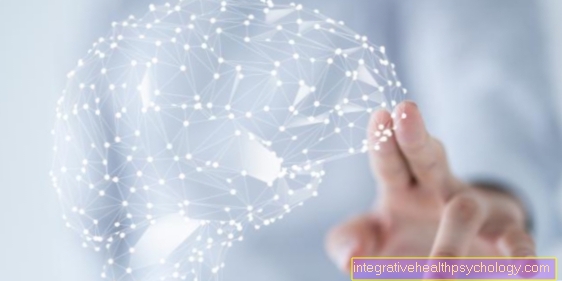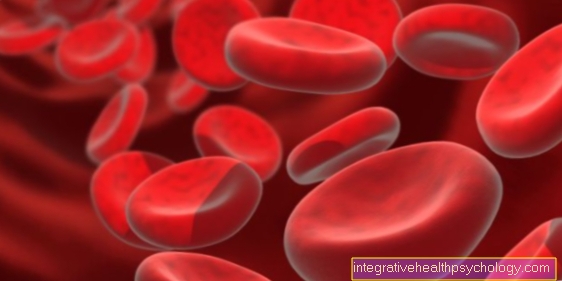Trigeminal neuralgia
introduction
Trigeminal neuralgia is one of the pain disorders that often occur without an underlying cause. Affected people suffer from brief attacks of extreme pain attacks in the facial area. The disease is named after the 5th cranial nerve, the so-called trigeminal nerve, in whose supply area the pain occurs.

What therapy options are there?
Various treatment options are used in the therapy of trigeminal neuralgia. These include:
- Medication
- surgical intervention
- radiotherapeutic method
- alternative healing methods
Carbamazepine, an anti-epileptic (actually used to treat seizures), is relatively well established in the treatment of trigeminal neuralgia, but the effectiveness of other drugs is continuously being researched in the course of studies. For acute treatment, phenytoin, also an anti-epileptic, can be administered intravenously.
There is also the option of injecting a local anesthetic near the affected trigeminal branch in order to temporarily prevent the pain from spreading.
Symptoms can be reduced by blocking the stellate ganglion nerve plexus. Read more about this under: Stellate ganglion blockage
For some sufferers, acupuncture also seems to have an (additional) soothing effect, and alternative medical mesotherapy can also be successful. Only when the conservative treatment options have been exhausted will an operation be considered.
Which procedure is used in each individual case requires careful consideration and should be clarified in discussion with the treating doctor.
Drugs used to treat trigeminal neuralgia
In trigeminal neuralgia, there is a presented scheme in drug treatment. Normally, monotherapy, i.e. treatment with only one drug, is sought. If this does not work, the therapy will be switched to another drug. The preparations are mostly anti-epileptic drugs that, in addition to the treatment of epilepsy, also include can be used in trigeminal neuralgia. Simple pain relievers, such as Paracetamol, do not apply.
The therapeutic agent of choice is carbamazepine, which is also popular in acute pain situations due to its quick-acting effect. Alternatively, oxacarbazepine can be given if the patient does not tolerate the carbamazepine or is taking other drugs that interact with it.
If the trigeminal neuralgia does not improve as a result, switch to second-line drugs. Gabapentin, for example, does not work as well, but is better tolerated by many people.
Another second choice drug is pregabalin, which also reduces the symptoms of trigeminal neuralgia, but rarely makes the pain go away completely.
Lyrica®
Lyrica® is the trade name of an anti-epileptic drug with the active ingredient pregabalin, which is mainly used for pain caused by nerves. In trigeminal neuralgia, it is one of the drugs of choice because it is less pain-free than other drugs.
The advantages of Lyrica, however, are that it still improves the overall symptoms and hardly interacts with other drugs. The side effects include Weight gain, dizziness, dry mouth and erectile dysfunction.
Are there any drugs for treatment without a prescription?
The drugs that are effective in relieving trigeminal neuralgia pain are anti-epileptic drugs that require a prescription and cannot be obtained from pharmacies without a prescription.
One can also try pain relief through over-the-counter homeopathic remedies, such as Arsenicum album, to diminish. The effectiveness of homeopathy is, however, strongly questioned when it comes to the severity of the pain attacks.
Read about this: Lidocaine plaster for your complaints without a prescription
What side effects do the drugs have?
The drugs for the treatment of trigeminal neuralgia belong to the group of anti-epileptics, which are used for other diseases in addition to epilepsy. These drugs often cause dizziness and double vision, affect the gastrointestinal tract in the form of abdominal pain and nausea, and with long-term use can attack the liver and kidneys.
In addition, carbamazepine must not be taken in the first trimester of pregnancy. Furthermore, anti-epileptic drugs change certain levels in the blood and lead to a decrease in sodium and white blood cells.
Surgical treatment of trigeminal neuralgia
Surgical treatment of trigeminal neuralgia is considered if the medication does not respond or if side effects are intolerable. The drug therapy is considered ineffective if there is no improvement after 3 months.
Various methods are available for the surgical treatment of trigeminal neuralgia. A distinction is made between methods without opening of the skull bone and methods that require opening of the skull bone.
The former include procedures that undertake mechanical, thermal or electrical sclerotherapy at a nerve switch, so-called transcutaneous stimulation-controlled thermocoagulation surgical methods. This achieves freedom from pain in more than 90% of cases, and the long-term results are also relatively good. However, side effects in the form of sensory disturbances and occasionally painful paresthesia in the supply area of the trigeminal nerve must be expected.
For methods that require an opening of the skull, for example a so-called microvascular decompression (Janetta operation). This relieves the nerve at the point of exit from the brain by placing a cushion made of muscle fibers or foreign material between the nerve and the surrounding vessels. Here, too, the early results are very good (freedom from pain or significant relief in 98% of the cases); over a 10-year period the success rate drops to 67%. Side effects are sensory disturbances in 3 - 30% of the cases, in up to 5% also a deafness in the ear of the treated side.
Radiosurgical procedures, in which the trigeminal nerve is irradiated near its exit point from the brain, are relatively new. Here, too, the success rates are good, they are around 85% freedom from pain initially, and after 3 years it is still 75%. As with the other procedures, side effects may include sensory disturbances in the supply area of the trigeminal nerve.
OP after Jannetta
The Jannetta operation is a so-called microvascular decompression procedure. This means that if there is close contact between the trigeminal nerve and a (in this case often calcified) vessel, a small piece of metal is inserted into it. The patient is under general anesthesia. As a result, the nerve is no longer constricted by the hardened vessel and the irritation that was responsible for the pain is eliminated. This surgical procedure has a very high success rate.
Risks of an operation according to Jannetta
Like every surgical procedure, the Jannetta OP also has certain risks. During this operation, the close proximity to one of the nerves that is responsible for hearing can lead to a limitation or loss of hearing on the affected side. Another rare complication is decreased sensation of touch or pain in the affected area of the trigeminal nerve.
Alternative healing methods in the therapy of trigeminal neuralgia
There are a number of alternative healing methods that can be used for trigeminal neuralgia. Some of these procedures have not been scientifically proven in their benefits, but are based on the experience reports of those affected. Alternative treatments include:
- acupuncture
- Osteopathy
- Homoeopathy
- Heat treatment
- Mesotherapy
- Vitamin B12
acupuncture
In Chinese medicine in particular, acupuncture is used as a very effective remedy for trigeminal neuralgia. The main cause here is a blockage of the life energy, the so-called Qi. The healthy side of the face is often acupunctured first in up to six sessions. A session lasts about 60 minutes. Then acupuncture is used on the diseased side. There are numerous reports of patients who have experienced freedom from pain through acupuncture and have thus regained a better quality of life.
Osteopathy
Many people with trigeminal neuralgia have seen significant improvement from osteopathy. Osteopathy is a manual procedure in which targeted movements promote relaxation of the muscles and fascia in the affected area.
In addition, the mobility of the corresponding bones, i.e. the skull and the jaw, is promoted and the lymph and blood flow are improved.
Heat treatment
The use of heat in trigeminal neuralgia is controversial. The purpose of a heat treatment is to stimulate blood circulation, which is usually relaxing when there is muscle cramps. In the case of sudden nerve irritation with pain attacks, cold is often more helpful, as it reduces the nerve conduction speed and thus the signals of pain perception can only be passed on to a reduced extent.
Furthermore, it should be noted that the heat or cold can lead to swelling, which is why the application should always be limited in time.
homeopathy
In some cases, with trigeminal neuralgia, homeopathic remedies can also improve the pain.However, since the pain often occurs in acute attacks and its character is described as very strong, stabbing and piercing, homeopathic remedies often do not play such an important role in treatment.
Arsenicum album (D6, D12, D30), Aconitum (C3, D4, D6) and Spigelia (D6, D12) are recommended for acute attacks.
Cedron, Iris versicolor and Plantago major can also be helpful.
Read more on the topic: Homeopathy for nerve pain
Taking vitamin B12
Vitamin B12 can also play a role in trigeminal neuralgia in some cases. The vitamin is a crucial substance in many inflammatory diseases, as it plays an important role in reducing inflammation in the body. If, for example, there is a deficiency in vitamin B12 (this can be demonstrated by a simple blood test), there may be a connection between this and inflammatory changes in nerves and the associated pain. Regular intake of vitamin B12 is very effective as a treatment.
forecast
In the course of the disease, spontaneous healing is possible, at least temporarily the disease can also be controlled with medication.
If the drug therapy fails, surgical procedures are available, which in most cases show good results.
Is trigeminal neuralgia curable?
Trigeminal neuralgia is not a curable disease in the classical sense. The aim is to provide the sick person with the longest possible pain-free or pain-free time. Since nerves are very sensitive parts of the body, complete freedom from pain is unfortunately not very often to be expected after prolonged irritation, whether from herpes zoster or constriction from a vessel.
About a third of patients with trigeminal neuralgia only have a phase with pain attacks once in their life. However, the course of the disease is often progressive, which means that the disease increases in intensity and should be treated with close medical supervision. With a well-adjusted therapy, a relative reduction in pain or even freedom from pain can be achieved in the majority of patients.
Frequently there are phases without symptoms and pain, which are referred to as spontaneous remissions. These last half a year for about half of all patients, and even a year for every fifth patient.
What are the underlying causes of trigeminal neuralgia?
Most often, trigeminal neuralgia occurs idiopathically, i.e. H. for no apparent cause.
In rarer cases, a local constriction of the nerve, for example due to arteriosclerotically changed vessels, leads to the picture of trigeminal neuralgia.
Likewise, inflammatory processes, dental diseases, injuries to the nerve caused by operations in the visual field or a skull base fracture near the origin of the trigeminal nerve can lead to irritation.
Stress or psychological stress can also be considered as triggers for nerve pain.
Inflammation of the trigeminal nerve
In addition to the classic causes (earlier these were referred to as "idiopathic", i.e. without a clear cause), there are symptomatic causes of trigeminal neuralgia, which are mostly based on an inflammatory process.
This includes, for example, the systemic disease multiple sclerosis, which is responsible for trigeminal neuralgia in 3% of cases. In this disease, the so-called marrow or myelin sheaths, which act as a protective covering around the nerve cords, are destroyed. This process, also known as demyelinating, is caused by inflammation and can also affect the trigeminal nerve. The immune cells of the body attack the myelin sheaths and ultimately lead to the typical inflammatory sharp pain along the nerve.
Another possible cause of the inflammation of the trigeminal nerve is what is known as post-zoster neuralgia. This is pain in the area of the nerve and its supply area caused by a previous infection with the varicella virus. The pain is most pronounced when touched and is often described as stabbing or piercing.
Read more on the topic: Inflammation of the trigeminal nerve
Diseases of the teeth
The third branch of the trigeminal nerve, the so-called mandibular nerve, supplies the teeth, among other things. Its end branches even end in small fibers in the teeth themselves. Therefore, various diseases of the teeth, such as an abscess or an extensive purulent inflammation, can lead to pain in the mandibular nerve.
Accordingly, the treatment of the cause, i.e. the dental disease, is in the foreground
Trigeminal neuralgia after dental, maxillary or sinus surgery
During various operations on the face and jaw, attention must be paid to the proximity of the trigeminal nerve to the area in which the operation is taking place. The trigeminal nerve has several branches that innervate the entire face sensitively, that is, are responsible for the sensation of touch and pain.
If one of these branches is irritated or injured during an operation, this can lead to severe pain or even trigeminal neuralgia in the affected area.
During an operation on the jaw, particular attention must be paid to the maxillary and mandibular branches. During an operation on the paranasal sinuses, the maxillary and frontal branches should be spared.
Occasionally, during dental operations, for example when removing the wisdom teeth, the terminal branches of the mandibular branch can be injured. This happens, for example, when a nerve branch sits around a tooth, which is an anatomical exception. Therefore, one should be informed about the possible risks for the development of trigeminal neuralgia before an appropriate operation.
stress
Nerves are among the most sensitive and vulnerable tissues in the human body. Therefore, even with pronounced physical and psychological stress, they can be irritated and cause pain, as can the trigeminal nerve.
The diagnosis can be confirmed by various neurological tests. During the treatment, relaxation techniques, acupuncture and the targeted reduction of stress should be considered in addition to drug therapy.
Mental causes
Trigeminal neuralgia can represent a possible expression of psychologically stressful problems. Many studies show that there is a great connection between the human psyche and his body. Therefore, psychological stress, especially pronounced stress, can express itself in the form of different pains in different parts of the body, also as trigeminal neuralgia.
diagnosis
The pain, sensitivity and temperature sensation in the facial area are recorded by recording the medical history (anamnesis) and by feeling (palpation) the pressure points or Sölder lines more precisely differentiated.
When collecting the medical history, the main focus is on inquiring about the characteristics of the pain and possible triggers. A subsequent neurological examination serves to rule out possible underlying neurological diseases as the cause of the pain. If the nerve or one of its branches is damaged directly “far from the center” (peripheral trigeminal lesion) then there is (punctual) (pressure) pain at the respective exit points, as well as when chewing and speaking (due to the chewing muscles innervated by the nerve). In the affected area, the facial muscles are often (involuntarily) tensed or begin to "tremble" (tonic or clonic) during the pain attack. After the pain attack, no new pain attack can be triggered for seconds or minutes (Refractory period). If the damage to the trigeminal nerve is the central cause, pain, sensitivity and temperature perception disorders occur in the area of the so-called Sölder lines. Depending on the nucleus in which the damage is present (nucleus mesencephalicus n. Trigemini, nucleus pricipalis n. Trigemini and nucleus spinalis n. Trigemini), it occurs in its supply area, the Sölder lines accordingly, to the disorders mentioned. X-ray and CT images of the head can be made in order to rule out space occupation in the skull.
Exclusion diseases
In addition to other forms of headache, injuries to the trigeminal nerve after accidents or operations can also be considered as differential diagnoses. Facial pain can also be caused by multiple sclerosis, herpes zoster, psychosomatic pain or calcification of the temporal artery.
This topic could also be of interest to you: Duration of an inflammation of the nerves
Symptoms of trigeminal neuralgia
If the fifth cranial nerve fails, usually in the context of inflammation, this can lead to nerve pain (trigeminal neuralgia). The main symptoms are sudden, intense facial pain (see also headache), which often occur on one side in the supply area of one or more branches of the trigeminal nerve (V1: N. ophthalmicus, V2: N. maxillary, V3: N. mandibularis) and from lacrimation and reddening and sweating of the skin in the affected area may be accompanied.
The nerve pain (neuralgia) lasts for a few seconds, the attacks can occur several times a day for weeks or months, but pain-free episodes occur again and again.
The pain can occur spontaneously as well as triggered by a trigger. Such triggers come e.g. B. Facial movements, chewing, brushing your teeth, speaking or a cold breeze. Those affected usually assign the intensity of the pain to the highest possible level on a scale; trigeminal neuralgia is one of the most painful diseases of all. As a result of this fact, numerous patients develop depressive moods, and the suicide rate among those affected is increased.
Read more on the subject at: Nerve inflammation on the face.
frequency
Trigeminal neuralgia occurs with a frequency of about 3 - 10/100000 in the population and occurs more in people over the age of 50, women are affected slightly more often than men.
Anatomical basis - the trigeminal nerve
Of the Trigeminal nerve is fifth Cranial nerve with its three branches on each half of the face responsible for the facial skin's sense of feeling. Furthermore, the masticatory muscles are motor-innervated by the lower branch of the nerve.




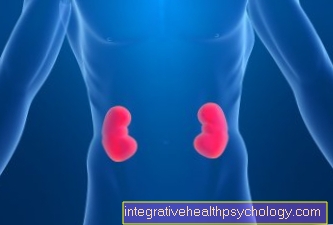
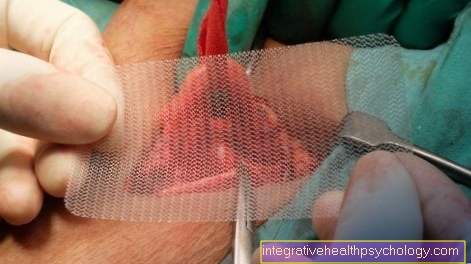

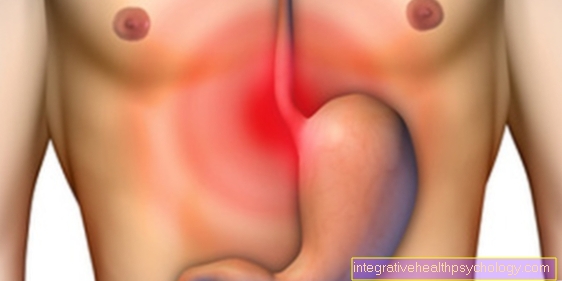
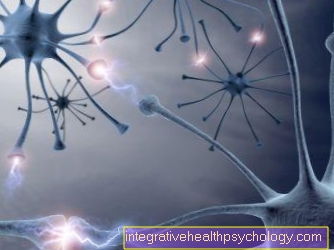


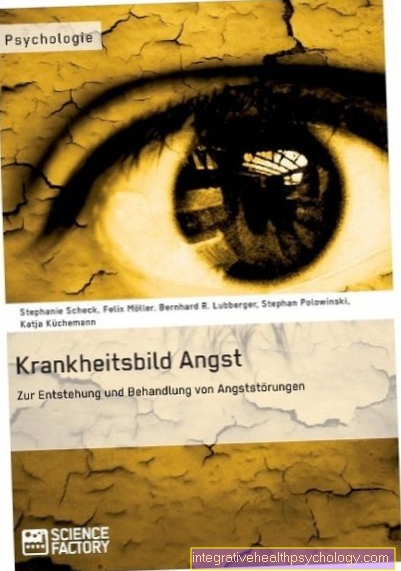


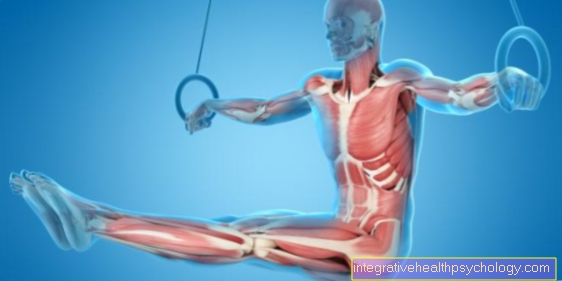



.jpg)




